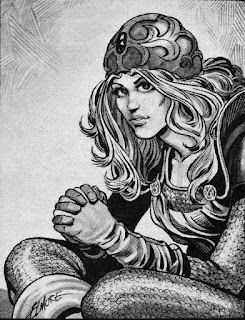The third edition of the D&D Basic Set was released in mid-1983, followed by a revised D&D Expert Set, shortly thereafter. Higher level play was to be covered in the D&D Companion Set (for character levels 15-25), and D&D Master Set (for character levels 26-36).
D&D Basic Set (3rd edition, 1983). Cover illustration by Larry Elmore.
The new Basic Set was revised by Frank Mentzer, who explained how he was assigned the job, and initial cover concepts for the new set, on a thread over at the Piazza in 2017,
here.
Original sketch for the cover painting of the D&D Basic Set (1983), by Larry Elmore.
Elmore described the creative process involved in "The Complete Elmore" vol. 1, pgs. 72-4, as recounted on a thread on Dragonsfoot,
here.
Interior illustrations were by Elmore, Jim Holloway, and Jeff Easley, for a very different "feel" than the B/X gang of Dee, LaForce (Diesel), Otus, Roslof, and Willingham.
The dedication was to president and founder of TSR Hobbies, E. Gary Gygax "with the greatest admiration, respect, and thanks."
Frank Mentzer:
Mentzer was hired by TSR in January, 1980. Later that same year, he won the 4th Invitational AD&D Masters Tournament at Gen Con XIII (see "He's the top Dungeon Mentzer" in Dragon #43).
From Dragon #43 (November, 1980)
The Red Box:
The set included a 64-page Players Manual, a 48-page Dungeon Masters Rulebook, a set of polyhedral dice (together with a crayon to fill in the numbers), and information on the RPGA.
The new Basic Set was discussed in "A New Game With a Familiar Name" by Frank Mentzer in Dragon #77 (September, 1983). In it, Mentzer states:
I changed almost nothing in the actual Basic game rules. The spell progressions for clerics and magic-users were a little lopsided, so I fixed those, but they'll only affect Expert-level play and up. I inverted the game mechanic for "opening doors"; now they open on 5-6 (on 1d6), and you just add your strength bonus to the roll. So minor things like that have been changed, for easier play, but the rest stands. It's just presented differently...
Frank Mentzer, Dragon #77 (September, 1983)
Aleena:
The first adventure involves a fateful encounter with a wicked magic-user "Bargle the Infamous" in which Aleena, a female cleric, is slain.
Brush and ink illustration by Larry Elmore.
In a post on Dragonsfoot, back in February, 2008, Mentzer revealed that Aleena was inspired by former girlfriend, Aileen Shea (now Reynolds).
He later posted a number of old character index cards on Facebook, in October, 2019, including one for Cenavia, a cleric played by Shea.
A year later, he posted a number of old PC sheets, including that of Aviance, a Lawful Good cleric played by Shea (including bust/waist/hip measurements).
The demise of Aleena inspired the free dice game Kill Bargle* (2008) and a Labyrinth Lord adventure "The Shrine of St. Aleena" (2014) by Peter C. Spahn.
*a reference to the "Kill Bill" movies, for those of you reading this in the distant future
Solo adventure:
Mentzer drew a complete map of the introductory dungeon featured in the solo adventure (along with a couple of new rooms) for a friend/fan in July, 2014.
A copy of the Red Box Map - Expanded (September, 2014)
He posted another version on ebay, the first of a planned series of 5 in 2014. A photo of #2 of the "Red Box Map - Expanded" was posted on Facebook in December, 2021, here.
For a fan expansion of the caves, check out "Find Bargle" an adventure for 4-6 characters of 1st-2nd level, published in Threshold #8 (July, 2015).
Characters:
Each character class description includes a sample name: Clarion, the Adept; Fleetwood, the Warrior; Felonius, the Seer; Greegan, the Footpad; Rolf, the (Dwarven) Warrior; Belrain, the (Elven) Warrior Seer; and Touchberry, the (Halfling) Warrior.
Mentzer discussed the origins of many of these names in this post on Dragonsfoot, back in 2008. (Felonius, a neutral mage, was one of his first characters, as discussed, here).
Legacy:
The design of the Red Box was re-used for the 4e Starter Set (2010), as noted in this review from Wired on September 22, 2010.
As 2023 marks the 40th anniversary of the launch of the BECMI line, I intend to focus on BECMI products over the course of this year (and likely, beyond).





















